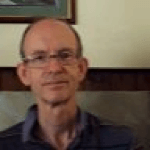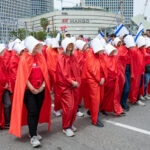Summary: In a land of staggering inequality, mass protests by grassroots organisations stay strong in the face of violent repression.
On 3 June, I watched a live webcast from Colombia, organised by LabourStart and Public Services International (PSI). The speakers were Margarita López and Francisco Maltés.
Margarita López is president of SINTRACUAVALLE, a union of water and sanitation workers in Valle del Cauca, and a member of PSI’s Global Women’s Committee.
Francisco Maltés is president of Colombia’s Central Union of Workers (CUT).
Francisco Maltés spoke quite briefly, as he was on his way to a meeting in Cali. Margarita López was able to speak at greater length.
This article is greatly indebted to their vivid and gripping account, while including information from other sources. When paraphrasing their remarks (from my notes taken from the simultaneous English-language translation), I shall indicate by name or initials.
Francisco Maltés explained that the social mobilisation began in November 2019, but was interrupted by the pandemic and lockdown.
The protests of 2019 were already the largest seen in the country since the 1970s, but have been surpassed by those of 2021.
In the pandemic, women have shouldered the greatest burden, losing paid work while having to do most unpaid care work.
The National Strike (Paro Nacional) was called in response to President Ivan Duque’s attempt to raise taxes on food and utilities, and at the same time to extend privatisation of health care. Duque then tried to suspend the constitutional right to protest, but this only strengthened support for the strike. Within days, Duque announced the withdrawal of these measures. The protests continued, expressing a desire for a different kind of society, an end to poverty and repression.
The desire for radical social change was symbolised by the action of protesters in Bogotá, who pulled down a statue of Spanish conquistador Gonzalo Jimenéz de Quesada, replacing it with the figure of Dilan Cruz, a 16-year-old youth killed by ESMAD riot police during the 2019 protests.
Margarita López said that the National Strike Committee was surprised by the strength of the movement. They expected a one-day strike on 28 April, but it is continuing after five weeks. The city of Cali has become the centre of resistance. She went there on 28 April, expecting to stay for eight days. All points of entry and exit to the city were barricaded by protestors, and her stay lasted 22 days. People created spaces of art, resistance and struggle but it was also very painful – they faced gas and bullets. She added that people now want participatory democracy – not representative democracy.
Repression has been widespread and very violent. 60 people have been killed while 40 have been blinded or suffered eye injuries. Many more have been arrested and tortured. Nevertheless, the movement has achieved some victories: some government ministers have resigned and the government had to allow observers from the Inter American Human Rights Court (IAHRC).
The National Strike Committee represents a broad coalition of social sectors: workers, retired people, students, Indigenous peoples and Afro-Colombians. (ML)
A Declaration issued in Cali on 6 May by a coalition of social organisations set out a long list of demands. Demands included:
- Urgently and immediately withdraw the military from all cities
- Reform the police and dismantle ESMAD
- A public apology for deaths caused by the security forces
- Universal basic income for all households in conditions of poverty and vulnerability
- Housing for the people and debt cancellation for tenants
- Commitment not to take judicial, criminal or disciplinary proceedings against all those who took part in the National Strike
- Justice for all state crimes and reparation for victims.
For the Cali declaration in full, see: Declaration from Cali 6th May 2021 – Colombia Solidarity Campaign
Indigenous people, who make up 4 percent of the population, have joined in the protests. Their very presence has spooked and outraged some government supporters, and they have received racist abuse – “Get out of here, Indians!” – and have been targeted for violence. Minga Indígena and other Indigenous organisations were signatories to the Cali Declaration.
La Violencia is the name given to a specific period from 1948 to 1958, but almost the whole of Colombia’s modern history has been violent and the country has been torn by civil war many times. The most recent civil war, between the state and the left-wing guerrilla groups FARC, ELN and M-19, began in the 1960s and dragged on for half a century. The most powerful group, the FARC, reached a peace deal with the government in 2017 and transformed itself into a legal political party, M-19 having already done so in 1990. Meanwhile the notorious drug cartels fought each other, the state and the guerrillas. Overlapping with the cartels were deadly right-wing militias.
The 2020 ITUC Global Rights Index, published by the International Trade Union Confederation, rated Colombia third (after Bangladesh and Brazil) on its list of the world’s worst countries for workers. The report states:
“Colombia remains one of the worst violators of trade union rights with a horrendous record for impunity regarding the murders of trade unionists. Between January 2019 and March 2020, 14 union leaders were assassinated. In addition, four attempted murders, one case of enforced disappearance and 198 cases of threats to life were recorded. Most of these crimes remained unresolved as the government still failed to address the culture of impunity in the country while the justice system remained dysfunctional and under-resourced. The sectors most affected by such extreme degree of violence and disregard for human life were the education, transport and mining and energy sectors.”
See: ituc_globalrightsindex_2020_en.pdf (ituc-csi.org)
As well as activists in labour unions and social movements, former guerrillas have been targeted for assassination by far-right militias.
Colombia is one of the world’s more unequal countries, with a Gini number (a standard measure of inequality) of 50.4, compared to 41.1 for the United States and 34.8 for the United Kingdom.
Rocio López writes: “I went to Colombia on vacation in 2016, shortly after the FARC peace deal vote failed (during the mass protests to revive the deal!), and I visited Cali. I am not at all surprised that Cail is the center of rioting. The level of wealth inequality I saw there shocked me and I’m American! The level of wealth on display in rich parts of Cali is extravagant. The nice parts of Cali seem nicer and even more upscale than what I’ve seen in Beverly Hills or WeHo in LA! It was obvious it’s completely unsustainable!”
Millions of poorer Colombians struggle with multiple disadvantages: low incomes, informal and insecure work, lack of essential services including clean water and garbage collection, bad roads, the list goes on. Conditions are particularly hard for Afro-Colombians.
The webcast ended with a call for international solidarity:
“Don’t leave us alone! Support our struggle!”
Margarita López also declared the need to “Bring out the Indigenous person inside us”.







0 Comments